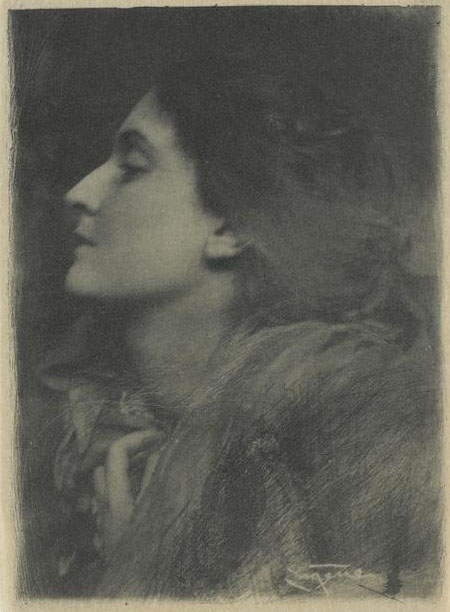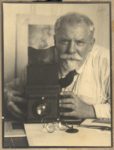
Frank Eugene
American, 1865-1936 (active Germany)
Lady of Charlotte, from the book, “the Camera Club, New York, American Pictorial Photography”, 1900 ca.
photogravure
4 5/8 x 3 3/ 8in.
SBMA, Museum purchase with funds provided by Michael G. Wilson and the Dana and Albert R. Broccoli Charitable Trust
1997.7.4

Frank Eugene Self-Portrait, 1924, from his book, The Dream of Beauty.
Frank Eugene was known as “The Master of the Manipulated Image.” Photographic historian, Weston Naef said, “…no one before him hand-worked negatives with such painterly intentions and a skill unsurpassed by his successors.”
RESEARCH PAPER
“Lady of Charlotte” evokes sensuality in what initially appears as a simple composition. Frank Eugene isolated his subject in a moody, smoky, and almost moonlit treatment of her facial structure. With his masterful use of light, shadow, and soft focus he brought a contrasting glow to her face and directs the viewers’ attention from her chin to her nose and up to the subtle glow above her left brow. Our eyes circle downward, following the illuminated portion of her face adjacent to her earlobe, and finally we notice the similar luminescence of her fingers, below her throat. Rippling rhythms of gentle angles repeating from her jawbone lead us to her nose, around her deep set eye, hairline, and ear which to her elongated throat and neckline, and finally, her exposed fingers.
Frank Eugene’s “Lady of Charlotte” on the surface appears to be an intimately candid cameo of a young woman. This profile captures a timeless quality, caught off guard in a wistful circumstance. Her gaze, reflective, casually attired to almost unkempt, her left hand grasps her clothing about her throat connoting both cool climate and collection of her emotions with this gesture. “Lady of Charlotte,” exemplifies his characteristically roughly hewn cross hatching and crude shading directly onto the negative, which created the printed image to be partially obscured by black lines. This American photographer enlisted his painting, etching, and printing expertise to lend poetic sensibility to his images’ negatives with the use of needles, paintbrushes and photographic processes to layer the desired lighting from behind observed in most of his work, primarily facial studies and nudes. He aggressively scratched his negatives to remove or reduce unwanted details to enhance the expressive characteristics of his subject.
“Lady of Charlotte” is a product of photogravure technique of photography. Also known as Heliogravure, developed by Karel Klic, an Austrian printer, in 1879 using bichromated gelatin which hardens proportionately to its exposure to light. This was reputed the finest method of reproducing a large format photograph and was derived from Talbot’s Photoglyphic Engraving patented in 1858, inventing the process of impregnating photo sensitive paper with silver iodide. Photogravure improved the process of printing a plate from a photograph. “Lady of Charlotte” is an example of gravures being printed on very fine paper and hand mounted onto brown or gray mats.
Responding to “Camera Work,” Clarence White from Ohio moved to New York and founded the American Pictorial School. Pictorialism was defined as an artistic endeavor and was distinguished from technical, documentary, scientific, and commercial photography. Its aesthetic fused emotions with images by balancing light and shade and employed techniques of manipulation in order to enhance the feeling of the composition by creating an “out of focus,’ visually textured, beautifully rendered and evocative result, often projecting a misty vignette, sepia toned photograph with pictorial meaning. The integral premise was that an image could be “built,” versus “snapped.” Theirs was an interpretation of an experience, paramount to recognizing the identity of the subject.
Frank Eugene was born in New York in 1865 and studied painting as a young man in Munich. He returned to New York and specialized in oil painted portraits of actors as well as photographic experimentation. Following his initial meeting with Alfred Stieglitz, the iconic mentor referred to Eugene as, “the sloppy fellow with the black fingernails,” remarking, “I don’t want him to come to my house.” Upon inspection of the young man’s photographs, Stieglitz reassessed his judgment, sharing their affinity for Munich, and built a long lasting friendship. This relationship is echoed in the title of Eugene’s 1899 portrait of the master, “Alfred Stieglitz Esquire. Photographer and Truthseeker.”
Frank Eugene was a founding member of the Photo-Secession movement, lead by renown photographer, Alfred Stieglitz, along with F. Holland Day. This trend was a response to, and departure from, photography merely as a means of recording events, versus manipulation of images in order to achieve the vision of a deliberately crafted and subjective finished piece of fine art. Experimentation and freedom of expression were keystone, including investigation and discovery of tools, chemistry and exotic paper choices. The Photo-Secessionists were dedicated Pictorialists who identified with the European secessionists of the late 19th century who exhibited photography alongside painting, drawing, and sculpture. Stieglitz determined that, “…a pictorial photograph be judged on its own merit as a work of art…”.
For Stieglitz an image had to qualify as being artistic and encompassed the dramatic painterly photographs of Frank Eugene, “whose images were so worked over with brushstrokes that they were often mistaken for drawings.” Like minded photographers broke away from the New York Camera Club exhibiting at “291” on Fifth Avenue (aka Little Galleries) donated by Edward Steichen and published the quarterly, “Camera Work.”
In November of 1899, Stieglitz sponsored a Camera Club exhibition of Frank Eugene’s photographs which some critics labeled as, “One of the worst installations in its history.” As his sponsor, Stieglitz respected his friend’s creative ingenuity and supported the versatile artist’s originality and personal expression, furthering his belief of the potential of photographs to be recognized at true works of fine art.
Eugene continued to be selected as one of the Photo-Secessionists representing the principles of stylistic sophisticated simplicity and informality included in hung works isolated with generosity of negative wall space affording the audience to absorb the image without visual distraction. Set in the context of societal inclination to rebuff the new, the Photo-Secessionist’s inaugural art opening was caustically debunked by “The New York Evening Sun” for their, “ . . . whimsical flourishes in which they habitually indulge, their incurable gravity . . . symptomatic of their essential frivolity.” His revolutionary work was often the focus of heated debates over whether or not a photograph should be altered in order to achieve an artistic effect and his “unorthodox methods” struck a nerve in the American “photography as art” movement of his time. The Photo-Secessionists were primarily active from 1885 through 1915, slowing down in the 20s and retreating from popularity at the end of WWII.
Little survives of Frank Eugene’s work today. It’s a statement in itself that although the identity of the “Lady of Charlotte,” is a mystery, it’s the emotional content which supersedes as the work is not intended as a conservative portrait study, but rather as a springboard with which to inspire a broader and universal emotional response.
Prepared by Deby Tygell for the SBMA Docent Council, 2018
Bibliography:
Baldwin, Gordon. “Looking at Photographs: A Guide to Technical Terms.” Los Angeles: The J. Paul Getty Museum, 1991.
Hostetler, Lisa. “Timeline of Art History.” New York: Metropolitan Museum of Art, Department of Photography, 2004.
Patino, Blaine. “Photography: Historical Developments-18th and 19th Centuries.” SBMA Docent Council.
Reed, Dennis and Wilson, Michael G. “Pictorialism in California: Photographs 1900-1940.” The J. Paul Getty Museum and The Henry E. Huntington Library and Art Gallery, 1994.
Taylor, Candice. “The Men Behind the Camera and Their Techniques.” SBMA Docent Library, 1998.
Whelan, Richard. “Alfred Stieglitz: A Biography.” New York: Little, Brown and Company, 1995.
http://www.photogravure.com.blog/2011/03/whats-wrong-with-this-picture/
https://theredlist.com/wiki-2-16-601-797-view-pictorialism-profile-eugene-frank.html/
COMMENTS
Born in New York, Frank Eugene spent most of his life in Germany, where he was an important figure in avant-garde photography and photographic education. He traveled to Germany for the first time in 1886 to attend the Bavarian Academy of Graphic Arts in Munich, and upon his return to New York in 1894, he studied photography and worked as a stage designer and portraitist. His strong painting background, combined with his expertise in etching and his affinity for Jugendstil, resulted in photographs with heavily manipulated surfaces and a hand-made sensibility. His Pictorialist works warranted his election to the Linked Ring Brotherhood in London in 1900 and recommended his work to Alfred Stieglitz, who in 1902 invited Eugene to be a founder-member of the Photo-Secession. Eugene established himself in Munich that same year, and was active in avant-garde photography organizations. In 1905 he joined the International Association of Art Photographers and three years later resigned from the Linked Ring. Eugene devoted the majority of his time to serving as a photographic educator in Germany, first in Munich and then in Leipzig.
Frank Eugene was significant in the Pictorialist movement of the early 1900s; his pictures helped fortify the connection between painting and photography that led to the acceptance of photography as a fine art. His facility with painting, etching, and such photographic techniques as the gum bichromate and autochrome processes have distinguished him as an accomplished practitioner of early-twentieth-century photography.
Lisa Hostetler
Handy et al. Reflections in a Glass Eye: Works from the International Center of Photography Collection, New York: Bulfinch Press in association with the International Center of Photography, 1999, p. 215.
